Table of Contents
ToggleIntroduction
Next up in our Socket A reviews, we have the Abit KT7A-RAID. It is based upon the VIA KT133A chipset and the revision of our sample is 1.1. Four revisions of the KT7A(-RAID) exist (1.0, 1.1, 1.2 and 1.3), of which only revision 1.3 is compatible with the Athlon XP.
The older revisions are limited to the Athlon Thunderbird and Duron Spitfire series of CPUs. There are old forum posts that suggest, that in some cases Palomino-based Athlon XPs run on older board revisions (sometimes with raised VCore), but to avoid problems, I advise to look for an Rev. 1.3 board, if an Athlon XP is the CPU of choice.
All KT7A revisions can be had with or without a Highpoint HPT370 RAID chip, recognizable by the “-RAID” suffix to the naming.
Gallery
Specifications and Features
Chipset:
- VIA KT133A (VT8363) Northbridge
- VIA VT82C686B Southbridge
CPU Support (with latest BIOS):
- Athlon Thunderbird (ALL)
- Duron Spitfire (ALL)
- Athlon XP Palomino (ALL, if board revision is 1.3)
- Athlon XP Thoroughbred (FSB266 models up to 2000+, if board revision is 1.3)
- Duron Morgan (ALL, if board revision is 1.3)
Memory Support:
- 3 SDR DIMM slots, up to 1,5 GB total
Expansion Slots:
- 1x AGP slot (1,5 / 3,3V) up to 4x
- 6x PCI slots
- 1x ISA slot
Connectors (internal):
- 2x IDE (UDMA100)
- 2x IDE RAID (UDMA100)
- 1x Floppy
- 2x USB 1.1
- 4x 3-pin fan connectors total (1x CPU + 3x chassis)
Connectors (external):
- 2x PS/2
- 2x COM/RS-232
- 1x Parallel Port
- 2x USB 1.1
I consider the lack of an onboard audio solution as a plus, as I think far better solutions than the old onboard chipsets are readily available for little money. Very commonly recommended are the Creative Soundblaster Live! cards for example, which offer fantastic compatibility with our beloved old games and sound far better than any onboard solution of that era.
I also don't list (from a retro-gamers perspective) useless connectors and features like IR, Smartcard- or Wake-on-LAN connectors and so on.
Overclocking Features:
- Adjustable Multiplier (BIOS) from x5 - x12 + "Over x12"
- Adjustable FSB (BIOS) from 100 to 183 MHz in 1 MHz steps
- Adjustable VCore (BIOS) from 1,100 V to 1,850 V in 0,025 V steps
- I/O Voltage (BIOS) from 3,20 V to 3,90 V in 0,10 V steps
The FSB setting of the KT7A-RAID is a bit “special” - first, you select one of the available presets, which are various steps between 100 and 155 MHz. Then, you are able to “finetune” the FSB with a maximum of +28 Mhz from your selected base-setting in 1 MHz steps. This results in a maximum configurable FSB of 183 MHz.
Overall, the BIOS design is great, almost all important performance options are packed together within the Softmenu III section. Additionally, there are lots of memory and chipset settings in the Advanced BIOS settings to finetune your system. A huge plus is also, that almost every BIOS option is explained in the manual. And by "explained" I mean explained and not just a description of the default value and available options. The KT7A-RAID is completely jumperless (apart from “Clear CMOS” and so on), which makes setting it up simple and “modern”.
Documentation, Downloads, Drivers
There are many manufacturers of the early socket A era, that do not exist anymore. Sadly Abit is also among them, as they closed doors by the end of 2008. Therefore it is not necessarily an easy task to obtain bios files, drivers and documentation, since you can't simply go to the manufacturer's website and download the required files.
There is a copy of the original website “www.abit.com.tw” which can be accessed via http://abit.ws, but some parts of the site do not work anymore and the downloads are also (mostly?) broken. Fortunately, the latest BIOS files can be obtained on this fantastic website: https://soggi.org/motherboards/abit.htm
There are also driver downloads for a huge share of old chips (network, storage, chipset, etc.) available on this part of the site: https://soggi.org/drivers/drivers.htm
In terms of documentation, there exist many websites that offer a huge amount of manuals.
Here is one of them, that I already used several times:
https://www.manualslib.com/brand/abit/motherboard.html
Alternatively, here is a FTP mirror of Abit's manuals: https://downloads.bl4ckb0x.de/ftp.abit.com.tw/pub/download/manual/
Please note, that not all manuals are available at any language there.
Regarding CPU support you can find the info here: https://www.cpu-upgrade.com/mb-ABIT/index.html
I already use this site for a long time and I always found the info to be very accurate. I cannot remember that I had a motherboard, that was not featured there. Great site.
To sum it up: using a motherboard of a manufacturer that is not around anymore might not be as straightforward as using an Asus or Gigabyte motherboard, for example. But, especially with an iconic brand like Abit, it is not an impossible thing to do.
Design & Layout
I must admit - I am a huge fan of how the early Abit Socket A mainboards look. The position of the CPU socket far in the upper left corner of the PCB create a look that I just love, I cannot even say why. Apart from my subjective feelings towards the layout - there is very little to complain about, from a practical point of view. The layout is close to perfect.
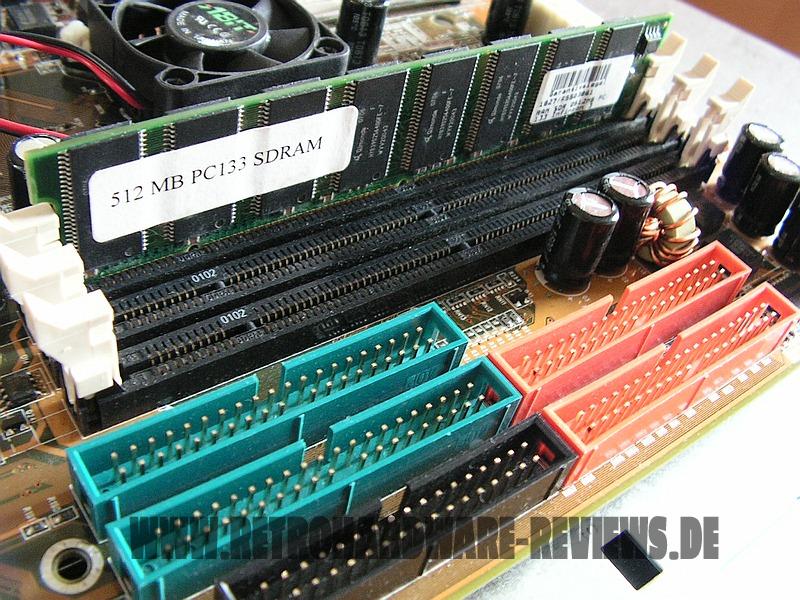
All IDE connectors, including the additional RAID connectors, are located in the upper right half of the board, to the edge of the PCB. The Floppy connector is in the same spot. This allows you to hide all ribbon cables nicely, so that they don't interfere with the airflow inside the system. The ATX power connector is placed on the top edge of the PCB, so that the power cable doesn't have to go over half of the board, which is also very helpful in terms of cooling.
The aforementioned position of the CPU socket can be a little problematic with some CPU coolers like the Cooler Master HHC-001, as the socket is located very close to the top edge of the PCB.
Quite some Cooler Master heatsinks (like the HHC-001) have a lever on the mounting bracket, that is supposed to help with the installation. But because the CPU socket is this close to the edge, the lever reaches out a bit over it. This makes it impossible to use such coolers on the KT7A-RAID in cases where there is no (or very little) space between PSU and motherboard. Furthermore, you will have to take apart your entire system, if you want to install another CPU, apply new thermal paste or use another cooler. All other coolers should fit without issues, even very large ones.
I tested the following seven models regarding compatibility and except for the HHC-001, all of them fit without a problem:
- Thermaltake Silent Boost K7
- Cooler Master HHC-001
- Swiftech MCX 370
- Alpha PAL 6035
- Alpha PAL 8045
- Smartcooler 60mm
- Arctic Cooling Copper Lite

Another small issue that many boards of that time have, is, that you are not able to swap memory modules as long as the graphics card is installed. This is also true for the KT7A-RAID, as the memory slots are close above the line of the AGP port. Even short cards make it impossible to replace the first memory module; longer cards like a Voodoo 5, or even the Geforce 4 Ti4200, will interfere with all three slots.

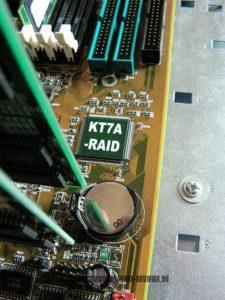
On the plus side, we have a very well placed CMOS battery socket and a total of three usable 3-pin fan headers for good ventilation. The well-labeled frontpanel connectors and the clean layout, with almost total absence of jumpers, make it an easy task to build an entire system around the KT7A-RAID without a single look into the manual.
Test-System and Parts
Baseline Setup:
- CPU: AMD Athlon Thunderbird 1200C (FSB133)
Because I want to compare 1st Gen Socket A mainboards to their DDR follow-ups I have to use a CPU, which is available in FSB100 and FSB133 versions with the same clockspeed. Since I sadly don't have a Thunderbird 1400 B at my disposal, I will use the Thunderbird 1200 for my reviews and comparisons of these boards, which I have in the “B” (FSB100) and “C” (FSB133) version.
- RAM: 1x “Infineon 3rd” 512 MB PC133 SD-RAM
This memory stick has Qimonda chips rated at 7ns (=143 MHz). It runs flawlessly with the tightest timings at 133 MHz and its size of 512MB is the perfect choice for Windows 98SE.
- VGA: MSI Geforce 4 TI4200-VTD8X
To remove any GPU bottleneck for testing, I chose a Geforce 4 Ti as the primary graphics card for my test setups. The Geforce 4 Ti series are also known to pull a lot of power from the AGP port, so that possible problems in that department can also be revealed. It is also somewhat period correct and a good match for a high performance retro-machine that should be able to run late Windows 98SE games without any issues.
- VGA2: 3dfx Voodoo 5 5500 AGP
Many people consider the Voodoo 5 5500 the perfect card for (Win9x-) retro gaming. The Voodoo 5 benefits from a beefy setup, so a powerful Athlon Thunderbird or early Athlon XP is the perfect match for this card.
- Audio: Creative Soundblaster Live! (SB0060)
Creative's Soundblaster Live! can be found in many retro-machines. It offers great sound, perfect Win98SE compatibility and is still widely available for reasonable money. It was also known to cause problems with VIA-based 686B southbridges using old BIOS revisions and VIA chipset drivers. All this should be history at this point, but double checking on pontentially affected mainboards is still not a bad thing to do.
- LAN: 3Com Etherlink XL PCI
Just a good, reliable choice for networking. All legacy Windows versions all the way up from Win95 have built-in drivers for it, which is also a huge “plus”.
- HDD: Western Digital WD200BB (20GB 7200RPM)
No special intention behind this drive, it is just “there” and still works fine.
Additional Hardware for certain Tests:
- Silicon Image Sil3512 SATA Controller & Samsung PM871 128GB SSD
These two will help me measure the PCI bandwidth.
- Hitachi Deskstar T7K500 (500GB 7200RPM)
This drive will tell us, how big we can go with the onboard IDE connectors and how the performance is like.
- 2x Voodoo 2 12MB (SLI)
A pair of Voodoo 2s is a must have for any retro-machine, that doesn't feature a 3dfx card as the primary VGA solution. They offer compatibility to older Glide games and can be used with any more powerful primary graphics card. It is an important thing to know, how well these perform and if there are differences between all the available Socket A chipsets of that era or even between boards using the same chipset.
Drivers used:
- Chipset: VIA Hyperion 4in1 4.56v
- Geforce 4: nVidia Forceware 43.45
- Voodoo 5: Amigamerlin 2.9
- Voodoo 2: FastVoodoo 4.6
- SB Live!: Some driver from my archive, not shure 😉
- 3Com NIC: Windows 98SE preloaded driver
- SATA Controller: Some driver from my archive, not shure 😉
System Setup and Usage
Before I started, I planned where to put the PCI cards. The Abit KT7A has 6 PCI Slots for us to work with, and during our testing, we'll have up to five PCI cards installed. The first PCI slot will be kept free, so that the video card has some more room for cooling.
In order to have a minimum of ressource-sharing across the expansion cards, we have to know which slots share ressources between each other and onboard devices like USB and IDE controllers. Fortunately, the manual provides enough information in that regard:

The way this reads:
- The VIA chipset provides 4 INT lines.
- Every PCI slot has a connection to each one of it.
- Devices will allocate an IRQ on these INT lines with PIRQ_0 coming first, to PIRQ_3 coming last.
- If a device needs one IRQ, it will allocate it on the INT line in the first row, the next respective IRQs the device needs, will be allocated in the order the INT lines are displayed in the table.
- The USB controller shares its IRQ with PCI #4 and allocates it on INT-D.
- According to the table, I would assume the card in PCI #6 also shares its IRQ with the USB controller, as well with the card that goes into PCI #4.
- The Highpoint RAID controller shares its IRQ with PCI #5
Since I also want to have a quick look at the Highpoint RAID Controller, PCI #5 will be used for the SATA storage controller, when the onboard Highpoint chip is deactivated. The Soundblaster goes into PCI #2, where it does not have to share ressources, the pair of Voodoo2 cards occupy PCI #3+4 and finally, the 3Com card takes PCI #6.
After this was sorted out, I started to put the system together, which was really straightforward. With a new CPU installed, the system always starts with FSB100 set. In the BIOS, you can then select a specific CPU or manually configure FSB, multiplier (if the CPU is unlocked) and VCore to your liking - no tinkering with jumpers and DIP switches necessary.
The first setup included the GeForce 4 Ti, along with the SB Live! and the 3Com NIC as expansion cards. I experienced repeatable CTDs (Crash-to-Desktop) during the second test of 3DMark99max, which could be solved by configuring waitstates for AGP reads and writes. Lowering the AGP speed to 2x did not help.
After the completion of the GeForce 4 benchmarking run, I installed the pair of Voodoo 2 cards, which completed all benches without struggle.
Next, I enabled the Highpoint RAID controller, to measure performance with a fast IDE drive, the Hitachi Deskstar T7K500. That was were the first problem occured - the system locked up during the Highpoint driver Installation. After a system reset, however, the Highpoint controller could be installed completely, but Windows froze during the subsequent shutdown. After another reset, I could complete the benchmarking of the Highpoint controller, but the shutdown / restart problems persisted - even when I disabled the controller again in the BIOS.
Finally, I wanted to check the PCI bandwidth with a Samsung SSD connected to a Silicon Image Sil3512 SATA card. I plugged the controller into PCI #5, installed the drivers and the card appeared to be operational after rebooting. The benchmarking of the SSD, however, could not be completed. The ATTO tool “stopped” during the measurement and the system also stopped responding, apart from mouse movement and the animation of the “Cancel” button when clicked.
After a system reset, I checked normal filecopy operations from the system HDD to the SSD, to rule out possible issues with the ATTO tool. But after a minute or so, first the filecopy seemed to stop, a few moments later, I got a blue screen with “Write Error”.
Next, I tried swapping PCI slots between the SB Live! and the SATA controller. The SATA card went into PCI #2, the Soundblaster into PCI #5. The drivers installed fine for both cards after the first boot, and the first thing I noticed, is that the shutdown problems disappeared. I immediately did another reboot and a shutdown sequence and this also went without issues.
This time, the benchmarking went all the way through, no lockups or strange behaviour. Why that is - I cannot tell for shure. The SB Live! card was installed with its VXD drivers, which also installs a virtual Soundblaster 16 card (SB16 Emulation). This device allocates an IRQ as well, which would connect to INT-D in PCI Slot #2. But in PCI Slot #5, the secondary INT line is INT-D as well, so there should be no difference.
INT-D is also conencted to the USB controller, which you would normally want to avoid with a Soundblaster Live!. But when using the SB16 Emulation, there is no chance to avoid this, if the manuals' INT table is correct. At least if you don't want the SB Live! or the SB16 Emulation to be on the same INT line as the graphics card...
Benchmarks
Synthetic Measurements
Before we get into the 3DMark and gaming benchmarks, let's have a look at some theoretical numbers. These synthetic tests will exhibit the differences between the several chipsets and boards better than any game benchmark and provide us with "background information" that might be of use in understanding the timedemo results later.
Memory Performance: AIDA64 Cache & Memory Benchmark
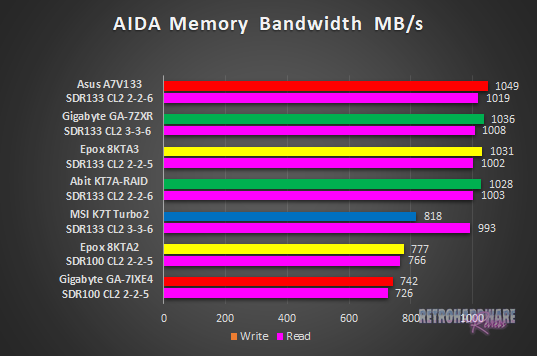
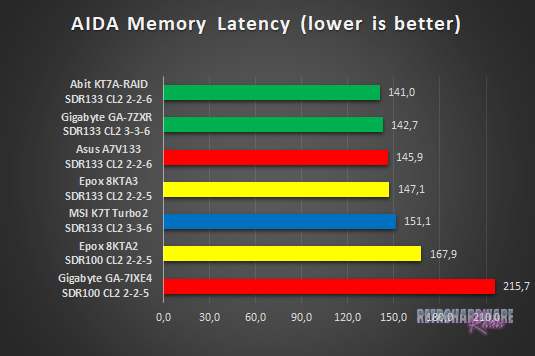
The KT7A-RAID shows very good memory latency values, taking first place in this test. It ranks fourth in the memory bandwith test, with values close to the GA-7ZXR and the EpoX 8KTA3 on places two and three, respectively.
Application Performance: 7-Zip
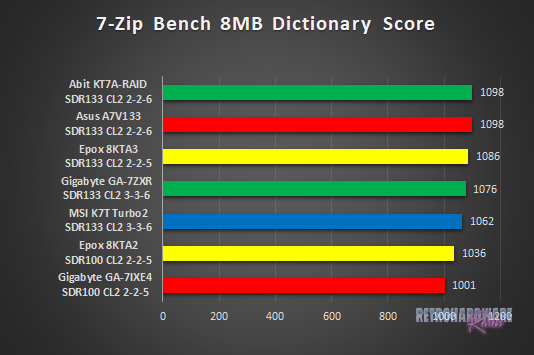
The Abit board shows excellent performance in the 7-Zip benchmark, ranking first along with the Asus A7V133, which scores identical.
AGP Performance: Final Reality Benchmark
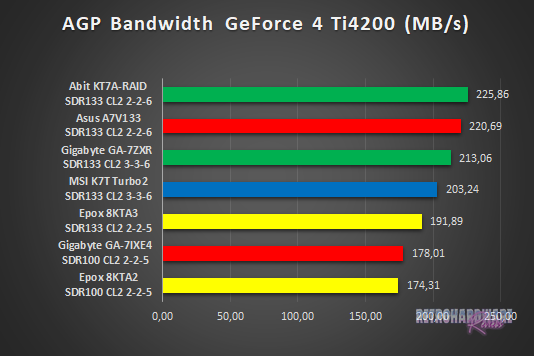

With the GeForce 4 Ti installed, the Abit board shows the highest AGP bandwidth among the tested boards. With the Voodoo 5 5500, it is a close second, along with MSI's K7T Turbo2, which achieves exactly the same bandwidth.
AGP and PCI Performance: 3DMark 2000 and ATTO
3DMark 2000 as a whole is very focused on TnL and is by far not as interesting for retro-hardware comparisons as its predecessor. Its “High Polygon Count, 1 Light” test, however, is another good way to measure the AGP performance. In opposite to the Final Reality test, the general system performance is also somewhat of importance. The benchmark was executed with the Geforce 4 Ti installed.
To measure PCI performance, I installed a Windows 98SE compatible SATA controller with a Samsung PM871 128GB SSD connected into the system. For the bench, I chose 1024 to 4096 KB block size and picked the overall best values for the read and write throughput. This test will show, which maximum performance can be expected with fast storage options like SATA or SCSI and maybe gives a hint, if the chipset might be good for Voodoo 2 cards.
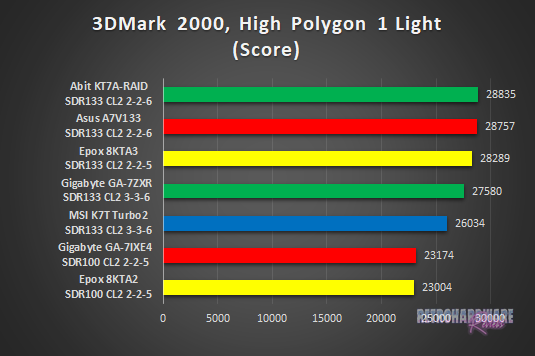
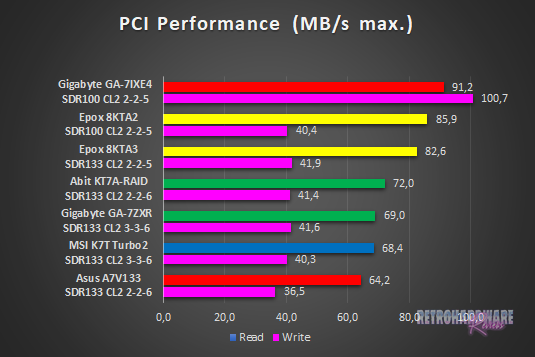
The excellent AGP bandwidth and memory performance grant the KT7A-RAID first place in the 3DMark2000 sub-test, slightly beating the Asus A7V133.
In the PCI bandwidth test, it shows the same weakness in write throughput, that all VIA KT133(/A) based boards seem to have. Read throughput could also be better, as the two EpoX board prove - overall it ranks fourth here.
Storage Performance: HDTach
To measure the performance of the board's IDE and (if available) onboard IDE RAID solutions' performance, I benched one of the latest and fastest IDE drives (the Hitachi Deskstar T7K500 500GB) with the HDTach benchmark. I also tried a much more “recent” drive (the Western Digital Blue Edition 500GB), which should be even faster in theory, but the Hitachi drive produced much better results in this test.
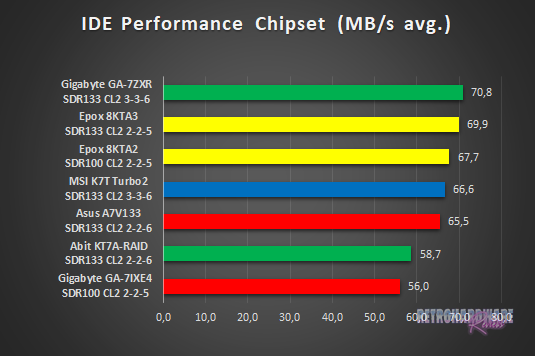
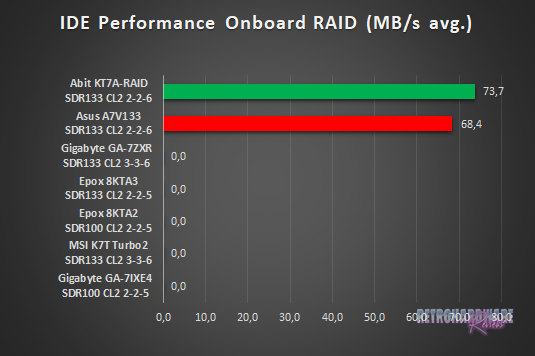
The board's IDE performance is pretty bad using the chipset-provided IDE ports - the KT7A-RAID ranks second to last, not far ahead of the GA-7IXE4 with its ancient AMD-756 southbridge, and about 20% behind the GA-7ZXR, which ranks first. At least its onboard Highpoint RAID chip shows good performance, giving it the overall fastest IDE-based storage option of all tested boards.
Gaming Benchmarks
Now that we got all the theoretical performance numbers, let's see how the contenders perform in 3D gaming benchmarks.
3D Performance: 3DMark99max
3DMark99max was released in early 1999 and comes without support for Hardware TnL. The maximum supported (hardware-) DirectX level is DX6. It is a great benchmark to reveal good overall system performance, as it rewards good memory bandwidth and latency more than the slight clockspeed advantage, that some boards have because of their factory-overclocked FSBs.
- Version: "latest"
- Settings: standard
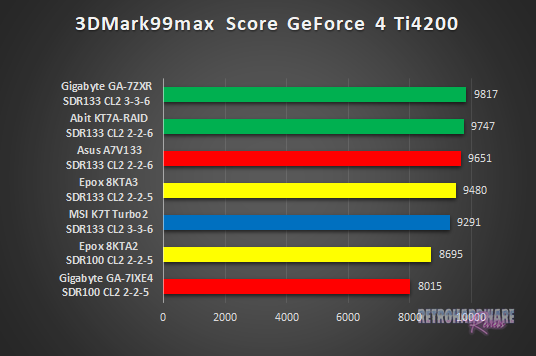
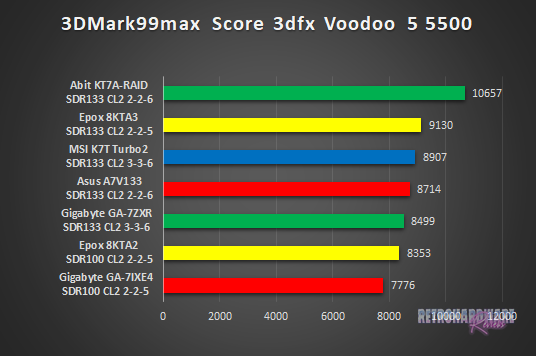
Things are starting to get interesting with our first 3D-based test. The KT7A-RAID shows good performance in conjuction the GeForce 4 Ti, taking second place, despite the AGP waitstates I had to configure for this card (see System Setup section). But its score with the Voodoo 5 is just lightyears ahead of the competition and even about 1000 points higher than its own result with the nVidia card.
This shure looks like an error on my side, but I double-checked this by repeating the benchmark, and got very similar results. I have seen a similar behaviour with another Abit board, the KG7-RAID, but I honestly have no explanation for it. All I can say is, it's repeatable and the test looks normal (no graphical glitches or so).
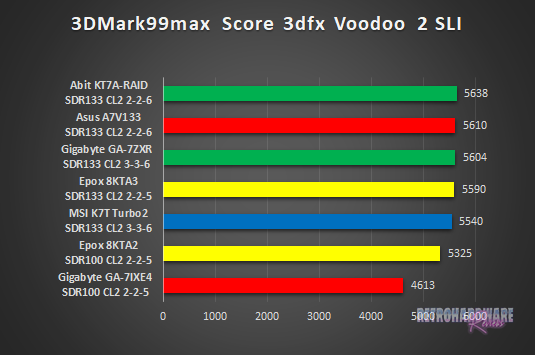
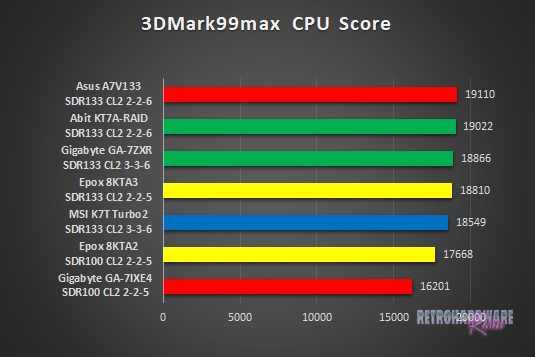
It also takes first place in the Voodoo 2 SLI run of 3DMark99max, 28 points ahead of the A7V133. It ranks second in terms of CPU score, this time behind the Asus board, which has a slight advantage in CPU clockspeed that probably helps here.
3D Performance: Unreal Tournament (UT99) Timedemo(s)
Unreal Tournament (UT99) was released in November 1999 and is notorious for its hunger for CPU power. I chose to use two different timedemos for comparison, of which the utbench.dem timedemo is heavily CPU bound and therefore qualifies to measure the general performance of the boards. The second timedemo benchmark.dem is as GPU limited as possible in this game. This will reveal, how much impact a faster board can still have in more GPU limited situations. This game is also perfect to show, on which chipsets and boards Voodoo 2 cards run best.
- Version: 4.36
- Settings: High, Min desired Framerate "0", Show Decals [x], Use Dynamic Lightning [x]
- Geforce: D3D
- Voodoo 2 and Voodoo 5: Glide
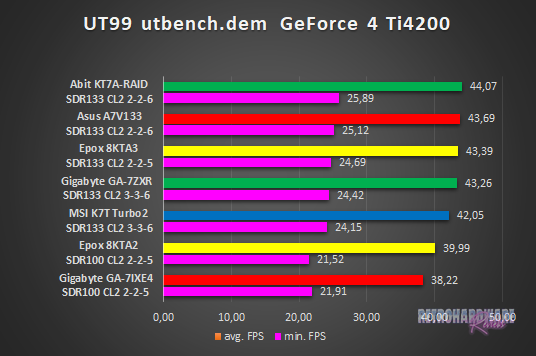
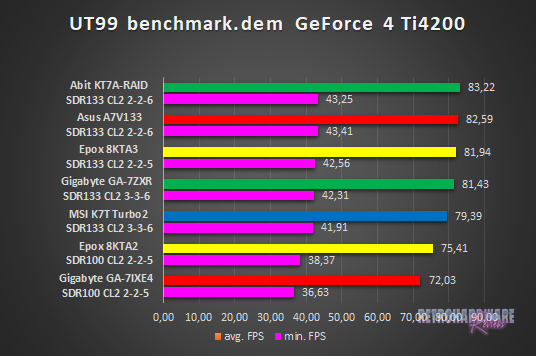
In the CPU-heavy utbench timedemo, the KT7A-RAID shows a very strong performance, with minimum FPS close to 26, where only the A7V133 scores just over 25 FPS and all other KT133A boards are in the 24,xx FPS range. With 44,07 FPS on average, it takes first place in the Geforce 4 Ti run of this timedemo.
It also ranks first in the second timedemo, with performance very similar to the Asus A7V133 in second place. The Abit board has a slight advantage in average FPS, the Asus board is slightly ahead in terms of minimum framerate.
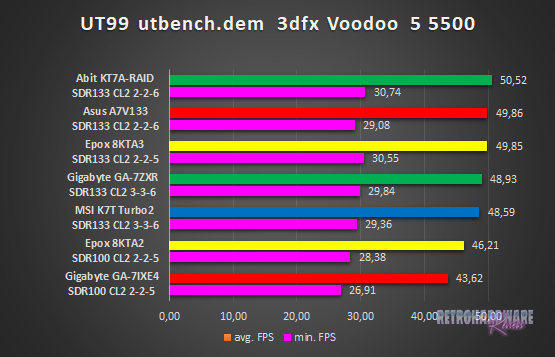
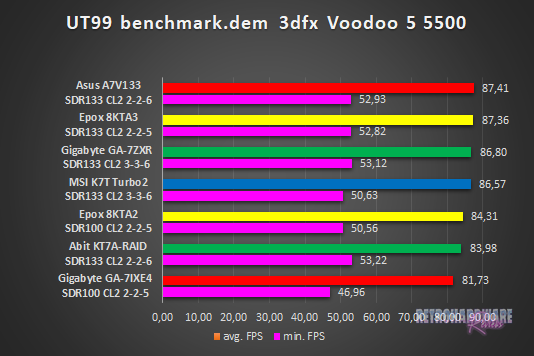
Like with the nVidia card, the KT7A-RAID also ranks first in the utbench with the Voodoo 5 5500 installed.
Something strange happens in the second timedemo, however. While the Abit board achieves the best minimum FPS, its average framerate is ~2,5 - 3,5 FPS lower than those of the other KT133A boards. This is another similarity it shares with the Abit KG7-RAID, besides the incredibly good 3DMark99max score when combined with the 3dfx card.
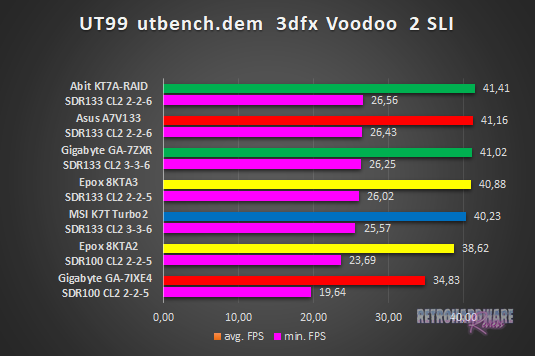
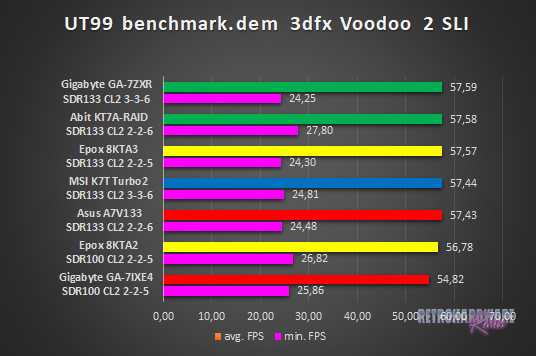
With the pair of Voodoo 2 cards on rendering duties, the Abit board achieves the third victory in the utbench timedemo. Results are very close among the first four boards, but the KT7A-RAID is the fastest in both average and minimum framerate.
In the benchmark.dem timedemo, the GA-7ZXR, the KT7A-RAID and the EpoX 8KTA3 basically achieve identical FPS on average, but the Abit board has the two 3dfx cards keeping the minimum FPS close to 28, whereas all other KT133A based boards drop to 24,xx FPS.
3D Performance: Quake III Arena Timedemo
Quake 3 Arena was released shortly after Unreal Tournament, in December of 1999. It is known to reward fast memory latency and with its normal preset, it is completely CPU limited; at least for the GeForce 4 and the Voodoo 5. The Voodoo 2 SLI cards clearly limit the Athlon 1200 here, as the timedemo will show.
- Version: 1.32
- Settings: “Normal” Preset, only resolution changed to 1024x768x16
- Geforce 5 and Voodoo5: OpenGL
- Voodoo 2: “Voodoo” Renderer (miniGL)
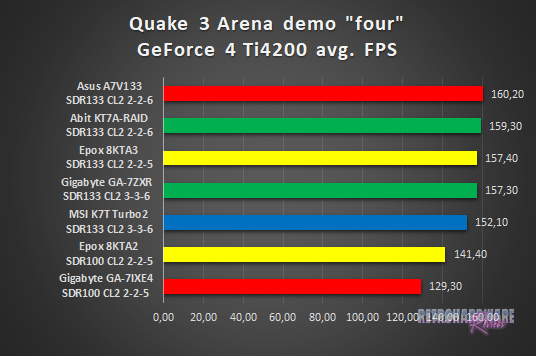
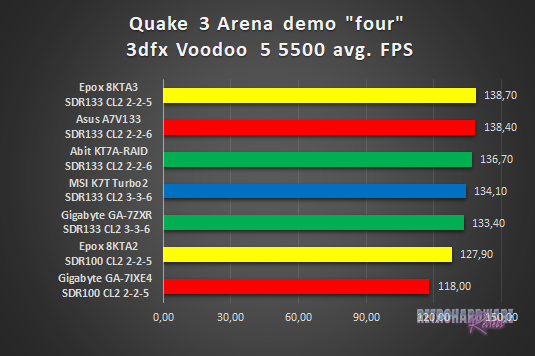
In the Quake III Arena benches, the KT7A-RAID does not show the level of dominance we saw in the UT benches just before.
With the GeForce 4 Ti installed, the Abit board takes second place, closely following the A7V133. In the Voodoo 5 run, the KT7A only ranks third, with about 2 FPS distance to the two boards ahead of it.
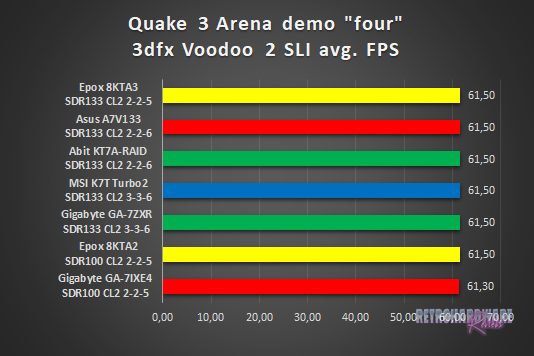
The Voodoo 2 SLI setup clearly limits here. All boards score the same FPS, with only the Gigabyte GA-7IXE4 being a close 0,2 FPS behind.
Summary & Rating
Abit KT7A-RAID (VIA KT133A)
-
Layout
-
Features
-
Overclocking Options
-
Compatibility
-
Documentation & Support
-
Performance: GeForce 4 Ti 4200
-
Performance: Voodoo 5 5500
-
Performance: Voodoo 2 SLI
OVERALL
| Pros | Cons |
| + Perfect set of expansion slots (1/6/1 AGP/PCI/ISA) | – AGP4x partially unstable with GeForce 4 Ti |
| + Great layout | – Possible issues with PCI expansion cards |
| + Easy to set up |





